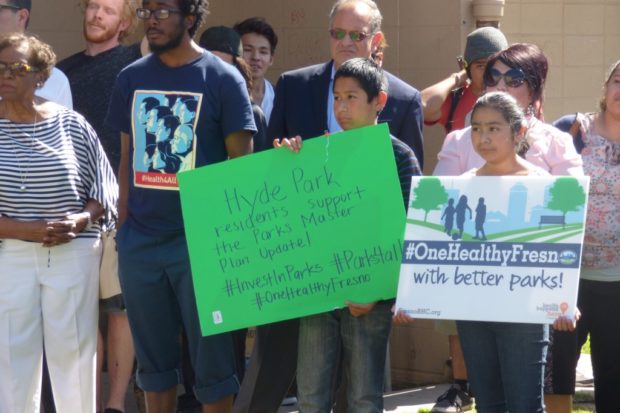
By Cesar Campos
Last month, the City of Fresno decided to censor an advertisement about park space on city buses. In a classic case of censorship, this advertisement was deemed too “political” by a dominant government structure, leaving many of us wandering “what exactly is political about it?”
Again, in a classic case of censorship the dominant group was reluctant to provide an explanation about the political elements that they felt were actively expressed in the advertisement and has instead leveraged their power to make that determination, unchallenged. That determination was made without consulting standards of political speech across their constituency, and one could argue without consulting standards of political speech within the law.
In a statement from Fresno Mayor Ashley Swearengin, she points out that the city “[has] to apply the rules consistently—whether or not [the city] agree[s] with the political statement being made.” Yet, the irony of this case is that it demonstrates the stark opposite of that. It does so because the content of the advertisement is utterly nonpolitical and instead uses City of Fresno data to inform about a discrepancy of park space within the city. The action from the city to label a nonpolitical message as “political” and then ban it is louder than a vague statement from the mayor.
It is problematic to have a dominant group assign and enforce standards in reaction to a proposed message because it provides for subjective determinations rather than objective treatment across all groups and messages. Even more troublesome is the liberty with which the city extended its power on this advertisement—making a demonstration that this could happen to any small group or nonprofit.
My experience working on issues of censorship does not come from political messages and government structures directly. Instead, I have more recognition of dominant group dynamics within mainstream media, and yet I see several parallels between media dynamics and this case in Fresno.
For several years, I have been part of an ongoing study to identify the prevalence of minority, low-income character and artist censorship in the media. The study hypothesizes that minority populations are disproportionately censored in their use of language, messaging, mannerism and political fluency in several media outlets (e.g., radio, television, newspapers). Often, these minority characters and artists are censored in response to standards that were created by the dominant or majority group.
That refers to any group that is unfamiliar, unconnected and unknowledgeable about cultural and linguistic mechanisms that allow members of a community to be expressive and clear in their message. Ultimately, this study seeks to understand the relationship between censorship standards for media outlets, which are then used as an avenue for limiting the voice, expression and creative activity of minority populations.
This pattern of censorship in the media represents an inability for minority characters to fully gauge creative expression and/or reach full communication with an audience. In this form, censorship serves to exert a layer of scrutiny on the messages of minorities that the dominant group does not receive given that the dominant group has used their dominant status to set the norm.
In his essay, “Re-appropriating Cultural Appropriation,” Kwame Dawes argues that policy making structures should “restructure themselves to allow non-white artists to feel and be included in the artistic mainstream. This means a redefinition of what constitutes mainstream—moving away from the notion that anything mainstream must be either white, or acceptable to whites.”
I’ll make the caveat here that when discussing censorship within the media, race is the prevalent power structure of study, and although the case in the city of Fresno is not explicitly about race—the dynamics between the city as a dominant group and the nonprofit as a marginal group share some parallels.
The city has used its power of determination to set a standard that implies that any message must either fall within the general messaging of the administration, or be acceptable to that administration. If it isn’t, this incident shows that the mayor will have no problem calling it “political” in order to silence it, disregarding its content and disregarding its benefit as a piece of communication. This is unacceptable. The fact that the city will feel at power to make this determination, provide no substantive evidence and/or deliberation of the elements at question, and do so confidently, without fear of outrage from its constituents, is outright alarming. I, for one, believe it is my civic duty to speak up about this situation.
This incident shows the blatant leveraging of government power to silence a minority voice. As residents of this city, we must keep strong scrutiny on government structures that are comfortable silencing any marginal voice simply because they can, and speak up when that is the case.
*****
Cesar Campos is coordinator for the Central California Environmental Justice Network. Contact him at cesar.campos.12@outlook.
